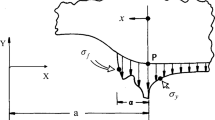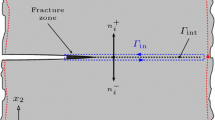Abstract
Transient crack growth behaviour resulting from time-dependent changes in crack-tip radius can occur near the fatigue limit. In the present work, mathematical expressions describing this transient behaviour are developed assuming that a dissolution reaction is responsible for changes in crack geometry. An elliptical crack is analysed because of its mathematical simplicity. The theoretical model slightly underestimates the extent of crack-tip blunting occurring below the fatigue limit. However, the predicted transient behaviour associated with the crack-tip sharpening processes which take place above the fatigue limit compares favourably with experimental data for glass.
Similar content being viewed by others
References
S. M. Wiederhorn,Int. J. Fract. Mech. 4 (1968) 171.
Idem, in “Fracture Mechanics of Ceramics”, Vol. 2, Edited by R. Bradt, D. P. Hasselman and F. F. Lange (Plenum, New York, 1974) pp. 613–646.
J. B. Wachtman, Jr.,J. Amer. Ceram. Soc. 57 (1974) 509.
B. J. S. Wilkins andR. Dutton,ibid. 59 (1976) 108.
R. J. Charles,J. Appl. Phys. 29 (1958) 1549.
S. M. Wiederhorn andL. H. Bolz,J. Amer. Ceram. Soc. 53 (1970) 543.
W. B. Hillig andR. J. Charles, “High-Strength Materials,” edited by V. F. Zackay (John Wiley and Sons, New York, 1965) pp. 681–705.
C. F. Inglis,Trans. Inst. Naval Architecture, London,55 (1913) 219.
T. A. Michalske, in “Fracture Mechanics of Ceramics,” Vol. 5, edited by R. C. Bradt, A. G. Evans, D. P. H. Hasselman and F. F. Lange (Plenum Press, New York, 1983) pp. 277–290.
S. Ito andM. Tomozawa,Comm. Amer. Ceram. Soc. 11 (1981) 160.
D. Hubbard andE. H. Hamilton,J. Res. Nat. Bur. Stand. 27 (1941) 143.
S. D. Brown,J. Amer. Ceram. Soc. 62 (1979) 515.
T. A. Michalske andS. W. Frieman,ibid. 66 (1983) 284.
H. Eyring andE. M. Eyring, in “Modern Chemical Kinetics,” edited by H. H. Sisler and C. A. Vanderwerf (Reinhold, New York, 1962) Ch. 4.
E. R. Fuller, private communication (1983).
M. G. Schwabel andV. D. Frechette, Paper 36-B-78, Presented at the 80th Annual Meeting of the American Ceramic Society, Detroit, Michigan, May 6–11, 1978,Amer. Ceram. Soc. Bull. 57 (1978) 307.
M. G. Schwabel, Ph.D. Thesis, New York State College of Ceramics, Alfred University, Alfred, NY (1978).
S. Ito andM. Tomozawa,J. Amer. Ceram. Soc. 65 (1982) 368.
Author information
Authors and Affiliations
Additional information
Research sponsored by Division of Materials Sciences, U.S. Department of Energy, under contract W-7405-eng-26 with the Union Carbide Corporation.
Rights and permissions
About this article
Cite this article
Ferber, M.K. A mathematical description of transient crack growth behaviour in glass. J Mater Sci 19, 2570–2574 (1984). https://doi.org/10.1007/BF00550811
Received:
Accepted:
Issue Date:
DOI: https://doi.org/10.1007/BF00550811




